ECONOMICS PAPER 2 GRADE 12 MEMORANDUM - NSC EXAMS PAST PAPERS AND MEMOS JUNE 2019
Share via Whatsapp Join our WhatsApp Group Join our Telegram GroupECONOMICS
PAPER 2
GRADE 12
NSC EXAMS
PAST PAPERS AND MEMOS JUNE 2019
MEMORANDUM
SECTION A (COMPULSORY)
QUESTION 1
1.1 MULTIPLE-CHOICE QUESTIONS
1.1.1 B ✓✓ equilibrium
1.1.2 D ✓✓ ceteris paribus
1.1.3 C ✓✓ average
1.1.4 B ✓✓ capital
1.1.5 C ✓✓ oligopoly
1.1.6 D ✓✓ discrimination
1.1.7 A ✓✓ collective
1.1.8 A ✓✓ information being made available (8 x 2) (16)
1.2 MATCHING ITEMS
1.2.1 D ✓ intersects AC at lowest point
1.2.2 G ✓ confirms, amends or sets aside any decision
1.2.3 A ✓ sometimes exploits consumers
1.2.4 B ✓ different businesses that produce the same product
1.2.5 F ✓ allows a firm to continue operating
1.2.6 C ✓ reduction in economic welfare caused by a reduction in both consumer and producer surplus
1.2.7 H ✓ a marketing strategy used to create a particular image in the minds of consumers
1.2.8 E ✓ interest rate at which the net present value of a project is zero (8 x 1) (8)
1.3 GIVE ONE TERM
1.3.1 Variable costs ✓
1.3.2 Market ✓
1.3.3 Inelastic demand ✓
1.3.4 Merit goods ✓
1.3.5 Minimum wage ✓
1.3.6 Explicit collusion ✓ (6 x 1) (6)
TOTAL SECTION A: 30
SECTION B
Answer any TWO of the three questions from this section in the ANSWER BOOK.
QUESTION 2: MICROECONOMICS
2.1 Answer the following questions.
2.1.1 List TWO forms of labour immobility.
- Geographic immobility ✓
- Occupational immobility ✓ (2)
2.1.2 Why would you prefer to run a monopoly rather than a perfect competitor?
- A monopoly makes economic profit in both the short and long run while a perfect competitor makes normal profit in the long run ✓✓
(Accept any relevant correct response) (2)
2.2
2.2.1 Give an example of a positive externality.
- Education ✓
- Health ✓
(Accept any other correct relevant example) (1)
2.2.2 Complete this statement:
A positive externality is a reason for …
- market failures. ✓ (1)
2.2.3 Briefly describe private benefits.
- Private benefits or internal benefits are benefits that accrue to those who buy the goods and services and those who produce them ✓✓ (2)
2.2.4 Explain the reason for the shift from DD to D1D1 in the graph above.
- DD shifts to D1D1 because the social benefit has been taken into account and as a result more is produced. ✓✓ (2)
2.2.5 How does the government deal with positive externalities? The government encourages positive externalities by:
- Advertising on the radio or television ✓✓
- Providing education, health care and other services at low cost or free to certain groups of people ✓✓
- Providing consumer subsidies ✓✓
(Accept any other correct relevant response.) (2 x 2) (4)
2.3 DATA RESPONSE
2.3.1 Give an example of a business in a monopoly.
- Eskom ✓
- Sasol ✓
- Transnet ✓ (Accept any correct relevant example) (1)
2.3.2 Identify ONE characteristic of the market structure mentioned in the cartoon above.
- There is one business – sole provider ✓
- It is a price maker – has market power ✓
- There is no competition ✓ (1)
2.3.3 Briefly describe an artificial monopoly.
- A monopoly caused by barriers to entry which are not economic in nature, e.g. patent, etc. ✓✓
- It is a monopoly created by law ✓✓ (2)
2.3.4 Explain a situation where the monopoly has no power.
- If the demand of the product is very low, then the monopolist will have no market for the product. ✓✓
(Accept any correct relevant explanation.) (2)
2.3.5 Why is the average revenue curve (AR) of a monopoly downward sloping? The average revenue curve (AR) slopes downwards because:
- The AR is the same as the demand curve ✓✓
- At higher prices less is demanded and at lower prices more is demanded ✓✓
- If the monopolist wishes to increase its sales by an additional unit, it must decrease the price of the product. ✓✓
(Accept any correct relevant response.) (2 x 2) (4)
2.4 Explain public goods as a reason for market failure.
- Public goods are those goods provided to all members of society by the state including community and collective goods. ✓✓
- They are high in demand but are not supplied by the market because of the low profit gained from them and the high cost of capital needed to supply them. ✓✓
- The reason for the failure of the market to supply public goods lies on the: - Non- excludability of public goods – consumption by one person does not exclude use by another, ✓✓ e.g. lighthouse ✓
- Non-rivalry – consumption cannot be confined to those who pay for it, ✓✓ free riders can use them ✓
- Non-rejectability – individuals are not able to abstain from consumption, ✓✓ e.g. streetlighting ✓
- Continuous consumption, ✓✓ e.g. traffic lights ✓
- Social benefits outstrip private benefits, ✓✓ e.g. healthcare and education ✓
(Maximum 4 marks for listing and examples). (4 x 2) (8)
2.5 Justify why a perfect market is unrealistic. The conditions of perfect competition make it unrealistic because of the following:
- Producing a homogeneous product, similar in all respect, cannot excite consumers ✓ ✓ everyone would like to be different as a result consumers prefer differentiated products ✓✓
- Having perfect knowledge about the behaviour of consumers and other firms is not really possible ✓✓ because people’s behaviours are subject to change at any moment ✓✓
- Complete freedom of entry and exit is not possible in the real world ✓✓ availability of barriers to entry prohibit perfect competition ✓✓
(Accept any correct relevant response) (4 x 2) (8) [40]
QUESTION 3: CONTEMPORARY ECONOMIC ISSUES
3.1
3.1.1 List TWO costs considered by economists in calculating profit.
- Implicit costs ✓
- Explicit costs ✓ (2)
3.1.2 Why are individual firms in a perfect market considered price takers?
- There are many small firms in the market such that one firm is insignificant and has no power to influence the price, then firms take the price determined by the industry ✓✓ (2)
3.2 DATA RESPONSE
3.2.1 In which market structure are cartels formed?
- Oligopoly ✓ (1)
3.2.2 Which policy does the government use to discourage the development of monopolies?
- Anti-monopoly Act / Competition Policy ✓ (1)
3.2.3 What will the Competition Commission do with its findings?
- The Competition Commission will make recommendations to the Competition Tribunal on the sentence to be given to the cartel ✓✓ (2)
3.2.4 Briefly explain the concept cartel.
- A group of producers whose goal is to form a collective monopoly in order to fix prices and limit supply and competition ✓✓ (2)
3.2.5 Why is it in the interest of producers to limit the level of competition in an industry?
Producers try to limit level of competition in order to:
- Make economic profit even in the long run ✓✓
- Have a large market share ✓✓
- Manipulate the market by selling goods at high prices ✓✓
(Accept any relevant correct response) (2 x 2) (4)
3.3 DATA RESPONSE
3.3.1 Which market structure do the graphs above represent?
- Perfect market ✓ (1)
3.3.2 Give a correct label for curve H in graph 2. (1)
- Average variable cost / AVC ✓
3.3.3 What effect will an increase in demand have on the market price?
- The market price increases ✓✓ (2)
3.3.4 Briefly describe the supply curve of an individual firm in this market structure.
- It is the rising part of a business’s marginal cost curve above the minimum of its average cost curve. ✓✓ (2)
3.3.5 Why will a business not produce to the left of point ‘g’? A business will not produce to the left of point ‘g’ because:
- Point g is a shut-down point ✓✓
- At any point to the left of ‘g’ price is less than the average variable costs (P< AVC) ✓✓
- The firm cannot cover its average variable costs ✓✓
(Accept any relevant correct explanation) (2 x 2) (4)
3.4 With the aid of a graph, explain why monopolies are considered to be both productive and allocative inefficient. 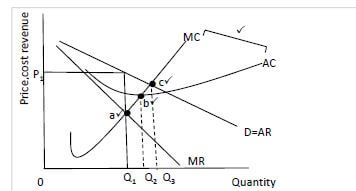
Mark allocation= Maximum 4 |
Productive inefficiency
- A monopoly firm produces Q1 instead of Q2 which is at the lowest point on the AC curve (point b) and consumers pay a high price P1 ✓✓
- This is because there is no competition in the market as there are barriers to entry.✓✓ (Max. 2)
Allocative inefficiency
- A monopoly firm is allocative inefficient because consumers are paying a high price P1 which is above MC (point c)/ (the price charged is not equal to marginal cost) ✓✓
- This is because the AR curve is always above the MR curve and at profit maximising output the price is always above the point where MR = MC. ✓✓ (Max. 2) (8)
3.5 Suppose there were ‘price wars’ in an oligopoly market. How will they affect consumers?
If there were price wars, consumers would benefit by:
- Paying lower prices for individual products ✓✓
- Allowing them power to buy more goods and services ✓✓
Consumers may also suffer by:
- Losing if firms shut down because of severe price wars and there will be less choice ✓✓
- Being exposed to low quality products as the market is less competitive ✓✓
- Rising prices in the long run ✓✓
(Accept any relevant correct explanation) (8) [40]
QUESTION 4: MICROECONOMICS AND CONTEMPORARY ECONOMIC ISSUES
4.1
4.1.1 List TWO types of oligopolies as determined by the nature of the product sold.
- Pure oligopoly ✓
- Differentiated oligopoly ✓ (2)
4.1.2 What effect does an increase in taxes on goods have on the economy?
- It makes goods to be expensive and many consumers cannot afford them ✓✓
- May lead to poverty ✓✓
- The government earns more revenue from taxes ✓✓
- Reduce production levels as some businesses may close down ✓✓
(Accept any correct relevant response) (2)
4.2 DATA RESPONSE
4.2.1 What is the product or service offered by Transnet?
- Transport services ✓ (1)
4.2.2 How much has Transnet lost by not conducting a CBA?
- R1,212 bn ✓ (1)
4.2.3 Briefly describe a cost benefit analysis.
- An analysis done by the government which weighs the costs and benefits of a project to determine whether it should be carried out or not. ✓✓
(Accept any correct relevant response) (2)
4.2.4 Explain a situation where the cost benefit ratio is greater than 1.
- The present value of economic benefits will be greater than the present value of economic costs and the public expenditure will increase the well-being of a nation. The project should be considered. ✓✓
(Accept any correct relevant explanation) (2)
4.2.5 Why is it necessary for Transnet to conduct a cost benefit analysis before embarking on the purchase of locomotives?
It is important because:
- Transnet is a parastatal (government institution) and a CBA is conducted by the government ✓✓
- The project of buying locomotives is really big – costs and benefits should be weighed, and a well-informed decision be taken ✓✓
(Accept any correct relevant explanation) (2 x 2) (4)
4.3 DATA RESPONSE
4.3.1 What is the equilibrium quantity level in the oligopoly above?
- 60 ✓ (1)
4.3.2 Which part of the demand curve is relatively price inelastic? Use labelling provided.
- BD1 ✓ (1)
4.3.3 Briefly describe a duopoly.
- A market structure dominated by two firms ✓✓ (2)
4.3.4 How will the dominant firm influence the behaviour of small competitors in the market?
- The dominant firm will take the lead in raising prices and the smaller firms will follow and raise their prices ✓✓ (2)
4.3.5 Why will the oligopoly not decrease the price from R80 to R40? Explain by means of calculations.
- The firm will lose revenue if it decreases the price ✓✓
- At a price of R80 there are 60 units sold which yields a revenue of R4 800 ✓
- While a decrease to R40 leads to 65 units sold and revenue of R2 600 ✓
- Loss will be R2 200 ✓✓ (2 x 2) (4)
4.4 With the aid of a graph, explain why marginal cost should be equal to marginal revenue to maximise profits. 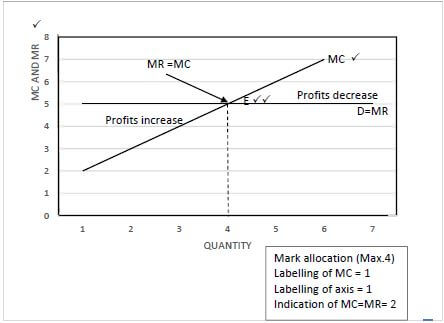
From units 1–3, MR is above MC and the profit of the firm increases ✓✓ The firm should continue to raise production of extra units of output as long as MR is greater than MC ✓✓ until MC = MR (a point where production is constant) ✓✓ because producing an extra unit beyond this point creates a higher marginal cost for the firm than it creates MR ✓✓ For example from units 5–7, MR is less than MC and the profit of the firm is decreasing ✓✓ At unit 4, MR=MC and it is where the firm maximises its profit ✓✓ (Max. 4) (8)
4.5 Evaluate the effects of implementing maximum prices.
Positive effects
The government sets a maximum price / price ceiling below the market price, thus:
- Making goods more affordable ✓✓
- Allowing greater access to basic foods, housing and transport ✓✓
- Reducing poverty because the poor will also have access to many goods ✓✓
- Improving the welfare of some consumers ✓✓
Negative effects
The suppliers will not be in favour of the implementation of a maximum price and this will result to:
- Decreasing the supply of goods ✓✓
- Shortages of goods in the market ✓✓
- Development of black markets (illegal markets) where people can obtain the goods ✓✓
(Accept any relevant correct response) (8) [40]
TOTAL SECTION B: 80
SECTION C
Answer ONE of the two questions from this section in the ANSWER BOOK.
QUESTION 5
- Discuss, with the aid of graphs, the individual business in a perfect market under the following headings:
- Derivation of the demand curve (10 marks)
- Economic profit (8 marks)
- Economic loss (8 marks)
- Evaluate the effect of free entry and exit into the market on the equilibrium position from short run to long run in a perfect market.
INTRODUCTION
A perfect market is a market with a large number of sellers who sell homogeneous products. ✓✓
(Accept any correct relevant response) (2)
MAIN PART
Derivation of demand curve of an individual business 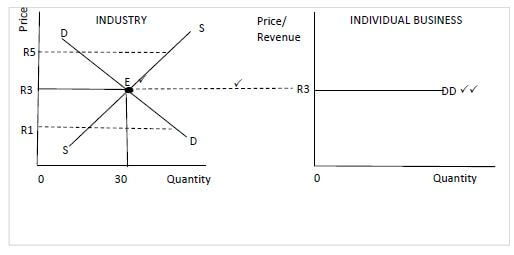
Mark allocation (Max. 4 marks) |
- The sellers are too insignificant to influence the market price, hence they are price takers ✓✓
- Each individual is forced to sell his goods at market price ✓✓
- Firms cannot manipulate the price but the quantities, thus the demand curve is horizontal / perfectly elastic ✓✓
- In the graph above, the firm takes price R3 from the industry as its selling price and the demand curve is DD ✓
Economic profit 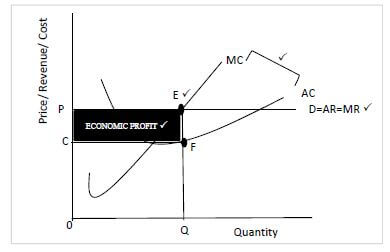
Mark allocation (Max. 4 marks) |
- A firm makes economic profit when average revenue is greater than average cost ✓✓
- The firm maximises profit at point E where MC=MR ✓✓
- AC is below AR at point F and the firm makes economic profit – PCFE ✓✓ (4)
Economic loss 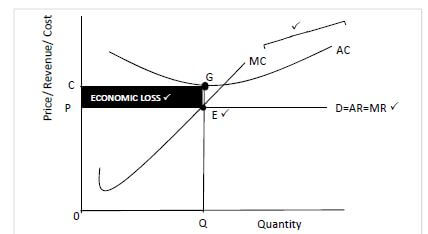
Mark allocation (Max. 4 marks) |
- A firm makes economic loss when average revenue is less than the average cost ✓✓
- The firm minimises loss at point E where MR=MC ✓✓
- AC is above AR at point G and the firm makes an economic loss – PCGE ✓✓ (4) (26)
ADDITIONAL PART
Free entry
- The economic profit made in the short run attracts new businesses to the industry ✓✓
- The quantity offered on the market increases, as a result of expansion by existing businesses, supply will increase ✓✓
- The price will drop and the firm will make normal profit ✓✓ (Max. 5)
Free exit
- The economic loss made in the short run will lead to firm exiting the industry ✓✓
- Less quantity will be offered and supply will decrease ✓✓
- The price will increase and the firm will make normal profit ✓✓
(Accept any other correct relevant response) (Max. 5) (10)
CONCLUSION
The perfect market is both productive and allocative efficient and produces at the lowest of the AC curve, sell the high quantity at the lowest price. ✓✓ (2) [40]
QUESTION 6: CONTEMPORARY ECONOMIC ISSUES
- Explain in detail the characteristics of monopolistic competition.
- How would competitors in monopolistic competition ensure their operational success in the market?
INTRODUCTION
Monopolistic competition is a market structure with a large number of sellers where entry is relatively easy but the product is differentiated, e.g. toothpaste. ✓✓
(Accept any correct relevant introduction) (2)
BODY
MAIN PART: CHARACTERISTICS OF MONOPOLISTIC COMPETITION
There are a large number of sellers in the market. ✓
- There is stiff competition between them. ✓✓
Products are differentiated ✓
- Products are similar but not identical because they satisfy same consumer need, e.g. clothing, shoes ✓✓
- There may be differences in packaging of a product that makes it different from other similar products, e.g. sugar ✓✓
- Differences may be imaginary, ✓✓ e.g. in the case of medicine where we find different brand names that contain exactly the same ingredients; here the service of the sellers will definitely make the difference ✓✓
There is free entry and exit to the market ✓
- It is easy for new firms to enter and to leave the industry ✓✓
- There are no barriers, permits, patents and complicated plant design ✓✓
- It is easy for businesses that wish to leave the industry to recover their capital expenditure on exit ✓✓
Incomplete information ✓
- There is lack of complete information for buyers and sellers ✓✓
Control over prices ✓
- Businesses have little control over the price ✓✓
- They do not compete over price but through differentiated products ✓✓
Hybrid structure ✓
- It is a combination of perfect competition and a monopoly.✓✓
- The element of competition stems from the fact that there are many sellers of differentiated products and that each is relatively small in relation to the market as a whole ✓✓
Often it is local ✓
- Monopolistic competition generally occurs in the retail and services sector of the economy ✓✓
(Accept any other correct relevant characteristic)
(Allocate a maximum of 8 marks for headings/listing and examples) (26)
ADDITIONAL PART
Businesses in the monopolistic competitive market can ensure their operational success by:
- Creating opportunities for non-price competition due to factors relating to their product’s uniqueness compared to those of competitors ✓✓
- Attracting more customers by advertising their products, making them more appealing to customers ✓✓
- Packaging their product in an attractive way for customers, making them stand out from those of competitors ✓✓
- Providing free deliveries for the convenience of their customers ✓✓
- Extending their working hours ✓✓
- Building customer loyalty through product branding ✓✓
- Giving out loyalty points to consumers for certain purchases ✓✓
(Accept any other correct relevant response)
(Award a maximum of 2 marks for mere listing and examples) (5 x 2) (10)
CONCLUSION
It is possible for a monopolistic competitive firm to make economic profit in the short run only and normal profit in the long run. ✓✓ (2) [40]
TOTAL SECTION C: 40
GRAND TOTAL: 150